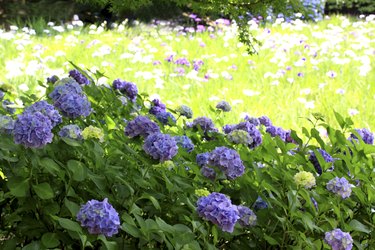
Hydrangea shrubs dress up your garden with large, showy flowers and beautiful foliage. They thrive in a full-sun location that also receives some late-afternoon shade. If you need to transplant them to a more optimal site, it's not a difficult procedure. During their dormant period, dig a new planting hole, dig out the plant's root ball and gently move the shrub to its new home.
Transplant Time
Video of the Day
Grown in U.S. Department of Agriculture plant hardiness zones 3 through 9, common hydrangea species include the pink or blue mophead variety (Hydrangea macrophylla), grown in USDA zones 6 through 9; and climbing hydrangea and oakleaf hydrangea, both hardy in USDA zones 5 through 9.
Video of the Day
Hydrangeas grow well in containers, and if you use this option, you don't have to think about transplanting. But if you have the shrubs in the ground and need to transplant, take action in winter while they are dormant. That way, the energy needed for transplant recovery doesn't steal the energy needed for growth and flower production. This also ensures plenty of time to recover ‒ all spring and summer ‒ as they enter the next dormant period. Technically, transplanting can be done any time between the first frost in late fall, to the last frost in early spring, but the best time is in late winter to early spring. At this time, the ground begins to soften to make digging easier, and the hydrangeas don't have to contend with harsh winter weather.
Plant Preparation
Little preparation is needed if the hydrangea was planted within the last year and isn't completely established in its site. For more established hydrangeas with vast root systems, root pruning in fall forces the plant to develop a dense network of short roots that reduces transplant shock. Cut a wide circle at least 24 inches in diameter with a sharp spade to sever the roots. You can also cut back hydrangeas to make them more manageable. Prune mophead, climbing and oakleaf hydrangeas immediately after flowering because they develop the next year's flowers in late summer to early fall. Prune panicle hydrangeas (Hydrangea paniculata) and smooth hydrangeas (Hydrangea arborescens), hardy in USDA zones 4 through 8 and 4 through 9 respectively, in fall or late winter because they develop new buds in spring. Cut back no more than one-third of a hydrangea's total height.
Site Preparation
Advanced site preparation increases the chance of transplant success. Dig the hole and have it ready before you even dig up the hydrangea plant. Loosen the soil in an area as wide and deep as possible, so the roots can easily pass through the loose soil. The hole itself should be as deep as the root ball height, usually about 24 inches, and two to three times the diameter of the root ball. If you root-prune a root ball that's 24 inches in diameter, the planting hole should measure 4 to 6 feet across. Hydrangeas need soil with adequate drainage to avoid root rot, so work in some organic matter and coarse sand, if needed, to build soil structure. Add sphagnum peat moss to increase acidity or agricultural lime to increase alkalinity, if the soil pH falls outside the range of about 5.2 to 7.5.
Moving and Planting
Spades work well for cutting the soil around the hydrangea plant, while a round-point shovel pulled backward provides leverage to break the bottom roots free from the soil. Remove the plant from its hole and set it on a piece of burlap. Wrap the root ball in the burlap to protect the roots. A large bush with a large root ball can weigh hundreds of pounds, so recruit helpers to move it to its new site. Use a garden cart or truck to transport the hydrangea. Alternatively, set the plant on a canvas dropcloth and pull it across the lawn to its new site. Set the plant in its hole, so the top of the root ball rests evenly with the surrounding soil grade. Backfill the hole with soil up to the root ball level.
After Care
One deep watering at the time of transplanting is usually enough until spring growth begins. The hydrangea is still dormant and doesn't require much water. Leave a soaker hose on in the area for several hours to ensure slow, steady watering that makes the soil in the hole and surrounding area evenly moist. The soil in the hole settles as the water fills in air pockets, so add more soil to bring the level back up to grade. Add fertilizer at transplanting time or wait until new growth begins in spring. Use a water-soluble, all-purpose, complete fertilizer mixed at a rate of 1 tablespoon fertilizer to 1 gallon of water. Add the fertilizer as part of the regular watering routine. Expect to use 1 gallon of fertilizer for every 10 square feet.